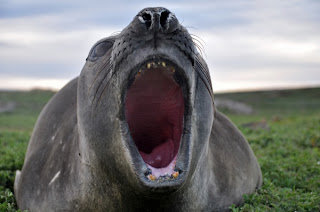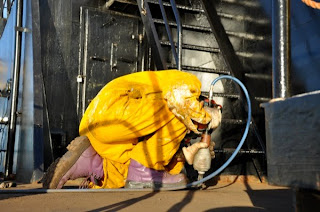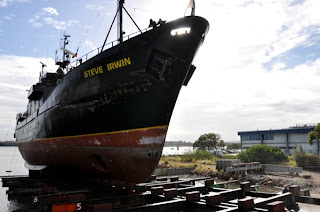
After spending the year in dock fixing up damage from last years campaign, a two month tour of Australian ports then a month of final preparation in Fremantle.. we were ready. A patched up hull, a new water cannon, and months worth of maintenance on everything from the leaky bridge windows to emptying, chipping and painting the very murky muddy depths of the chain locker.
Stocked up and full of secrets and excitement we dropped the lines and headed south. The biggest secret was of course the new super tough ship, the Bob Barker, who were were going to meet up with in Antarctica.
It all started sooner than expected when just a day out of port a ship appeared behind us on the radar, matching our speed and course. It had been lurking on the edge of Australian and International waters and fell in behind us heading south. It was the, now famous for its psychotic ramming tendencies, Shonan Maru No. 2. The Shonan Maru is an old harpoon ship, and faster than the Steve Irwin, so we could not out run it and a problem for us at it could relay our co-ordinates to the whaling fleet so they could steer clear of us.
So to keep them from getting to close we set up a stern line ready to deploy of the back of the ship to keep those harpoon ships at bay. We used this tactic successfully last year several times last year (link is to an Animal Planet 'out take about this - My only screen time!). A few days later the helicopter had just landed after a reconnaissance mission and the heli-deck team were getting the blades off, the Shonan Maru No. 2 powered up its engines and came in on the attack, trying to hit and disable the chopper with its water cannons. A few of us sprinted to the aft deck and as the Shonan Maru approached we got our stern line out and watched the Shonan Maru suddenly drop speed and back off. HA! But apart from that and a few more times when they came aggressively close to attempt to intimidate us (HA! again) things were too quiet for us with them on our tail.
The next week followed days of preparing nice little surprises for the fleet and final training on launching the boats. We have the boat launching down this year, with new attachment points for the handling lines welded to the ship and new gear, and lots of training for the crew lead to much smother controlled launching of the boats and hopefully less dramatic scene of the boats swinging about on 'Whale Wars'.
Cape Dennison
After an usually calm crossing of the southern ocean we reached the Antarctic coast, we saw some amazing icebergs, Orcas swam by the ship and the great continent's ice cliffs loomed.
We were waiting for the Ady Gill to catch us up so we had a day to wait out, so we headed into the near by Commonwealth Bay and dropped Anchor at Cape Dennison late into the never darkening night under the midnight sun. A few hours later started a fantastic 'Day off' in Antarctica that was a welcome break and adventure.
Cape Dennison is the windiest place on earth, but luck was with us as the ocean was flat glassy calm and the sun was shining.
The Day started with a swim with the penguins. Leaping of the ship then hitting that point of no return, that short but acute moment where you are in mid-air and yet to plunge into icy depths of the Antarctic ocean, overshadowed by the crumbling ice cliffs of the continent edge, and you wonder how much of a good idea this really was and can you change your mind? Oh Crap. Then just as quick your submerged and it all goes very primal and there is no thought at all apart from cold.. get out.. cold.. get out.. cold..
We had made some friends over the radio with scientists and archaeologists working ashore who had seen this strange ship come in and anchor, who figured that the only Black ship in these waters had to be Sea Shepherd and called us. We got the Delta in the water and got ready to for one of the crew who parachuted out of the helicopter and landed on the ship, it looked way off at first, but he'd he made the impossible looking jump perfectly and didn't end up taking a second dip of the day!
After that we made landfall, and we got to walk out on the icy shores of Antarctica! A total lifelong dream come true. The approach to the bay was surreal and exciting, we passed little bergs a few of meters away with Adele penguins hanging out in the flows, while others bobbed in and out of the water. The surrounding rocks were home to a large penguin colony and the water was full of leaping darting shapes. Out on the land they really are the most adorable clumsy folk. They waddle about and fall over so often that sometimes they just push themselves around on the ice on their bellys like they cant be bothered to get back up again. I took about a hundred penguin photos, every one a cutie! It was strange to be looking through a camera lens at things I'd only seem before in National Geographic, or with David Atonbrough narrating.
The folks there were restoring Mawsons Hut an old frozen hut from explorers in 1912, there was still food, books, magazines and smelling salts preserved by the ice. By coincidence Dan and I had seen an exhibition of photos from the Original mission in Hobart about six months ago, and never thought we would be walking into the original hut and seeing the darkroom used by the photographer still there 100 years later.

Scientists working there had been struggling to retrieve a tidal data collector five meters under the water in the bay, so a couple of our divers plunged out of the delta while we looked on from above... brrr. After a search it was found and we hauled it up from the depths, mission accomplished. On the way into shore a confused penguin jumped out of the water and into the delta landing on my foot, it thought we were an iceberg, we had to help it back into the sea.
So.. long day on the ice and the water, stomping in the snow, cruising under ice cliffs, driving the delta around chunks of ice in the water and I now look like a genuine Antarctic explorer with a glowing red wind and sun burned face and white goggle eyes... Very cool.
Then we set off for a midnight rendezvous with the Ady Gill... where we sent over supplies before heading back to port to shake our spy-ship tail and refuel.
We were almost back to the Antarctic continent from refuelling in Hobart when the news came through, slowly in rumours that spread around the ship from group to group, from the bridge out to the deck where we were preparing our 'gifts' for the whaling fleet, across the dishes, around the tea time que for the toaster, a head stuck around the galley door... "The Ady Gill been rammed" "Oh that doesn't sound good" "How bad?" "The bow have been completely seared off!" " Jesus!" " Are they OK?" "How are the crew" "Is the Bob there?" "Have they been rescued?" "Is is sinking?" "Are they leaking fuel?" "It was totally the Shonan Maru No. 2's fault" "They were trying to kill them!"
We started heading to their position full speed. Finally the sad news came in that our new funky James Bond-esque speed boat had gone down. Luckily, apart from some painful broken ribs, all the crew were OK. Before it sank they had managed a through salvage operation and pulled up most of the gear, and most importantly all the fuel was pumped off so it didn't end up in the ocean. Our new secret ship, the Bob Barker was on the scene and handling the rescue.
The Nisshin Maru factory ship, who the Ady Gill had been following, had done a runner in the chaos and could be back to business chopping up whales so we broke of from joining the rescue and started to chase after them around the Antarctic continent for nearly two weeks to keep them running and not whaling. We sailed for days and days leaving the world behind us, ending up in one of the remotest places you could be, as close to Rio de Janeiro as to Fremantle. Rio or Freo?
We searched the ice edge, where the nutrients off the continent mean more krill for the whales to eat. More eyes peeled, and off work folks adding to the eyes on the bridge looking out for the fleet. We were searching around the Amery Ice Shelf before we had to turn back.
View Larger Map
We had got word that the Bob Needed help with some mechanical problems, the Ady Gill shipwreck survivors need to get back to land and our chopper was sick and needed replacement parts. So we were to help out and head back to land. However the Bob was being tailed and we didn't want to meet up where the spy-ships could harass us, so it was decided to meet at the mysterious fog shrouded islands of Kerguelen, in the middle of the Indian Ocean. Being of French territory the Japanese Harpoon ships would not enter, so we could sneak in before the Bob arrived and not get spotted, and then both ships could sneak out in the fog and get away.
Kerguelen
We approached Kerguelen at dawn, surrounded in a shroud of orangey pink mist. We headed for a sheltered harbour we entered the mouth of bay, the only hint of land being lines of solid green blobs on the radar. A pair of Commerson Dolphins spot us and start to ride our bow and within minuets others are hurtling out of the fog from all directions till we have about twelve of them playfully escorting us in. Now we are totally surrounded by mountains, but still all is pinky grey as still we are shrouded by fog. Then dark and pointy peaks start to appear in the mist then we brake through the wall of fog to see high snow capped alpine peaks and volcanic calderas and rocky lava plug peaks. Again we were very lucky with the weather, as most days of the year the islands is shrouded completely in fog and its rare to ever see the mountains. The bay is filled with the barks of mammoth fighting elephant seals, the calls of circling birds and chirps of penguins swimming by. Some of the remotes islands of Earth, shrouded in fog; what a place for a secret rendezvous.
A few hours later the Bob arrived, first we see it on the radar, hidden by the same wall of fog in which we arrived, then we were in range of our handheld radios and familiar voices come over the airwaves. Jibbing them about having just got out of the shower (their water maker was struggling in the Antarctic waters and they were on major restrictions and had not had showers or clean clothes for weeks!). Eyes peeled most of the crew were out on the decks waiting for that first glimpse of the ship we'd heard so much about. Then after what seemed forever a dark and craggy shape started emerging out of the fog looking just like the 'Black Pearl' from the pirates of the Caribbean.
We moored up together for twelve hours of loading across barrels, gear, water and crew. Before a crazy storm blew up and in howling winds separated the two ships and got ready to depart.
My story ends here as after 12 of the 15 months on the ship, 2 campagains and a Dry-docking it was time for a break..
The final third leg ended up being full of action... with both the Bob Barker and the Steve Irwin catching the fleet and keeping on their tail for 3 more weeks, this up close and stinky. The now-sunk Ady Gill captain Pete Bethune succeeding in a very daring night time boarding of the Shonan Maru No. 2 by jet ski - then lurking unnoticed on the ship for 90 minuets till dawn before knocking on the bridge door with a bill for the sinking of his ship, being taken prisoner and back to Japan. A very successful summer in Antarctica.
Check my Operation Musashi blog for more about the whaling fleet, what they do and about last year where I was more in the thick of the action - And my Drydock blog where we were all very in the thick of the rust action!
Check out my Sea Shepherd & Antarctica photos on flickr.






























































